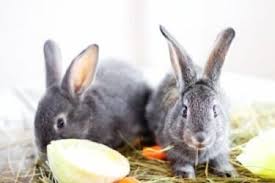Tips for Feeding Your Rabbit the Best Diet
Rabbits Need 3 Items for a Proper Diet
Rabbits need a good source of soluble and insoluble fibers, protein, and vitamins, and minerals. You should limit fats and carbohydrates as these can lead to obesity and affect the gastrointestinal (GI) bacteria.
 Learn More
Learn More
Fibers
Proteins
Vitamins and Minerals
Hay, Grasses and Legumes
These should be the main component of your rabbit’s diet. Rabbits should always have access to hay as this is the main source of soluble and insoluble fibers.
Young, growing rabbits, pregnant and nursing females can be fed alfalfa since the alfalfa is high is in protein. Also, offer timothy hay or other meadow hays. As a fun fact, did you know alfalfa is not a hay, but a legume?!
Adult rabbits should be fed mainly timothy or other meadow hays since they’re lower in calcium and protein. These are less likely to contribute to obesity and bladder stones, which can occur if your rabbit eats mainly alfalfa hay.
READ ALSO: How to Start Rabbit Farming Business
Be sure to purchase smaller quantities of hay to keep it fresh. Store your rabbit’s hay in cool conditions to deter the breakdown of vitamins.
If your rabbit has access to the outdoors, you can have them graze on grasses outside for a few hours each day. Be sure they’re in an enclosure that keeps them safe from predators like hawks, cats, etc.
Eating hay is the main way to keep your rabbit’s teeth filed down naturally. The abrasive nature of the hay is key to preventing overgrown teeth. If your rabbit’s teeth do not get filed down while eating, they can develop points that cut into the inner cheeks and/or entrap the tongue.
Fresh Greens
Fresh greens give your rabbit additional fiber, water, and vitamins. These should be introduced gradually and in small volumes to allow your rabbit’s GI microbes to adjust, thus reducing GI upset and diarrhea.
Greens your rabbit might enjoy:
collard
mustard
dandelion leaves
parsley
cilantro
basil
broccoli
kale
cauliflower
green bell peppers
cabbage
spring mix
lettuce
chard
bok choy
celery leaves
You should offer about 1 cup per 2.5 pounds of body weight per day at the most. Again, be sure to introduce these gradually, and slowly increase the amount offered to allow the GI microbes time to adjust.
Fruits and Other Veggies
Strawberries, carrots, and apples should be given in small amounts as treats.
Pelleted Diets
Pelleted diets are not needed if your rabbit is a non-breeding adult and is already eating a diet of high-quality hay and fresh greens. However, many owners prefer to include pellets into their pet’s diet, which is fine.
READ ALSO: Preventing Parasite Build up in Pig Farming Systems
Growing rabbits and pregnant or lactating rabbits should have pellets included as part of their diet.
For our pet rabbits that are adults, a pelleted diet should have at least 18% fiber. Most are made of timothy hay. Keep the volume offered small, no more than ¼ cup of pellets per 5 pounds of body weight. If your rabbit is overweight, greatly reduce the pellets or eliminate them entirely. Focusing on hay and greens will be the best for your bunny.
Just like the hay, be sure to keep the pellets in a cool place (fridge or freezer even) and in airtight containers to keep the vitamins and minerals at the recommended levels.
Cecotrophs?
Cecotrophs are a treat your rabbit makes himself! These are special fecal pellets your rabbit produces at night and are smaller and softer than the day time feces. Your rabbit will ingest these at night directly from the anus and swallow them whole. The cecotrophs contain vitamins, bacteria, yeast, and amino acids. They’re essential for maintaining GI health and movement. Rabbits with overgrown teeth, obesity, or back pain may not be able to ingest these, which can lead to additional medical issues.
Make Eating Fun
Hang bits of carrots, greens, and hay from food dispensing hammocks or racks, clip them to higher bars of the cage, put treats into hay balls, etc. This gives your rabbit something to work on. Entertaining them during mealtime reduces boredom, aggression, and stereotypic behaviors like pacing, moving their head back and forth, etc.














